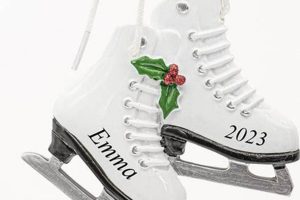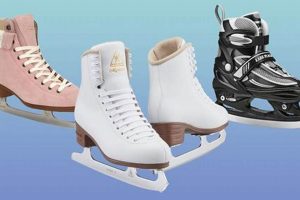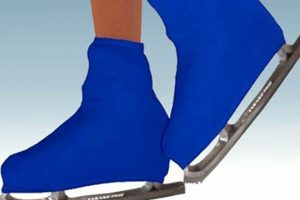The most suitable introductory footwear for ice skating is designed to provide support, stability, and comfort for beginners. These skates typically feature enhanced ankle support, a forgiving blade profile, and comfortable internal padding to facilitate learning fundamental skating techniques. An example would be a recreational skate with a reinforced synthetic upper and a pre-sharpened blade.
Selecting appropriate beginner-level skates is crucial for fostering a positive initial experience with ice skating. Well-fitted, supportive skates can minimize the risk of injury, improve balance and control, and ultimately accelerate the learning process. Historically, rudimentary skate designs offered minimal support, making the learning curve significantly steeper; modern advancements have prioritized user comfort and safety, making ice skating more accessible.
The subsequent sections will delve into specific features to consider when evaluating introductory-level skates, including boot construction, blade materials, sizing guidelines, and maintenance tips, providing a comprehensive overview for selecting the ideal option.
Guidance for Selecting Appropriate Entry-Level Ice Skates
The following recommendations aim to provide informed guidance in the selection process. These tips are designed to assist individuals in making a suitable choice based on individual needs and intended use.
Tip 1: Prioritize Ankle Support: Adequate ankle support is paramount for beginners. Opt for skates with a firm shell and sufficient padding around the ankle to prevent instability and potential injury. Example: A recreational skate with reinforced synthetic leather and a built-in ankle brace.
Tip 2: Consider Blade Material: Stainless steel blades offer a balance of durability and performance for recreational use. Avoid carbon steel blades, which are prone to rust and require more frequent sharpening. Example: A skate listing “stainless steel blade” in its product specifications.
Tip 3: Ensure Proper Fit: A snug, yet comfortable fit is essential. The toes should lightly brush the front of the boot while standing, and the heel should be securely locked in place. Ill-fitting skates can lead to blisters and reduced control. It’s best to try on skates with socks of similar thickness to those that will be worn while skating.
Tip 4: Pre-Sharpened Blades: Verify that the blades are pre-sharpened before first use. Dull blades significantly impede skating performance and increase the risk of falling. If necessary, have the blades professionally sharpened before initial use.
Tip 5: Research Boot Stiffness: Recreational skates generally have a lower stiffness rating, offering more flexibility and comfort. However, more rigid boots provide greater support for individuals with weaker ankles or those intending to learn more advanced skating techniques.
Tip 6: Consider Closure System: Laces offer the most customizable fit, but buckles and straps can provide easier and quicker fastening. A combination of lace and buckle systems can provide both security and convenience. Ensure the chosen system is easily adjustable.
Tip 7: Evaluate Padding and Lining: Look for skates with ample padding and a moisture-wicking lining to enhance comfort and prevent blisters. Removable liners are beneficial for cleaning and drying.
Selecting appropriate entry-level ice skates requires careful consideration of various factors, prioritizing safety, comfort, and performance. Adhering to these guidelines will significantly improve the learning experience and minimize the risk of injury.
The subsequent section will address the importance of proper skate maintenance to ensure longevity and optimal performance.
1. Ankle Support
Ankle support is a primary determinant in the efficacy and safety of introductory ice skates. The level of support directly influences a beginner skater’s stability, control, and susceptibility to injury.
- Lateral Stability
Adequate ankle support minimizes lateral movement, preventing the ankle from rolling inwards or outwards during strides and turns. Without sufficient support, a beginner skater may struggle to maintain balance, leading to falls and potential sprains. A recreational skate with reinforced ankle padding provides this needed stability.
- Injury Prevention
Insufficient ankle support elevates the risk of ankle injuries, particularly sprains and strains. Stiffer boot materials and reinforced construction mitigate the likelihood of these injuries by restricting excessive ankle movement. Skates without adequate support force the skater to compensate with other muscle groups, increasing fatigue and the risk of other injuries.
- Learning Curve
Enhanced ankle support facilitates a more rapid and positive learning experience. Beginners can focus on developing fundamental skating techniques without the distraction of instability. Skates with structured ankle support allow beginners to confidently practice basic skills such as forward skating, stopping, and turning.
- Energy Efficiency
Proper ankle support improves energy efficiency by reducing the amount of effort required to maintain balance and control. Skates with substantial ankle support allow skaters to transfer power more effectively, enabling longer skating sessions with less fatigue. The skater is able to make better edge work due to efficient support.
In summation, ankle support significantly impacts the overall performance and safety of introductory ice skates. Skates lacking adequate support compromise stability, elevate injury risk, hinder skill development, and increase energy expenditure, ultimately detracting from the beginner skater’s experience.
2. Blade Quality
Blade quality is a critical determinant in the performance and suitability of introductory ice skates. The material composition, edge geometry, and hardness of the blade directly influence a beginner’s ability to glide, turn, and stop effectively. Substandard blades can impede learning, increase the risk of falls, and discourage further participation.
Stainless steel blades are typically preferred for starter ice skates due to their resistance to corrosion and ease of maintenance. Carbon steel blades, while offering superior edge retention when properly maintained, are more susceptible to rust and require diligent care that is often beyond the capabilities or interest of novice skaters. The blade’s edge geometry, or “hollow,” affects its grip on the ice; a shallower hollow provides greater glide but less bite, while a deeper hollow offers more grip but less speed. A moderate hollow is generally recommended for beginners to balance these factors. An example of practical significance would be a beginner attempting to learn the “snowplow stop” with dull or improperly shaped blades. The inefficiency of the blades would make stopping difficult, increasing the risk of collision or loss of control.
In conclusion, blade quality is inextricably linked to the functionality and safety of introductory ice skates. The selection of appropriate blade material and geometry is paramount for fostering a positive initial experience and promoting skill development. While advanced blade characteristics may become relevant for experienced skaters, the durability, ease of maintenance, and suitability for fundamental maneuvers are the primary considerations for selecting introductory-level ice skates.
3. Proper Fit
The relationship between proper fit and introductory ice skates is one of fundamental importance, directly influencing both the safety and the learning progression of a beginner skater. A properly fitted skate functions as a direct extension of the foot, enabling precise control and efficient energy transfer. Conversely, an ill-fitting skate introduces a cascade of negative effects, ranging from discomfort and blisters to compromised balance and increased risk of injury.
The effects of an improper fit are numerous. A skate that is too large allows the foot to move within the boot, leading to friction and blisters. This movement also reduces the skater’s ability to control the blade effectively. A skate that is too small compresses the foot, restricting circulation and causing pain, potentially leading to long-term foot problems. Furthermore, an improperly sized skate inhibits the skater’s ability to maintain balance and execute basic maneuvers, such as forward skating, stopping, and turning. A real-world example would be a skater wearing skates that are a half-size too large. They may experience excessive movement within the boot, leading to an unstable ankle and difficulty controlling their edges, making it more challenging to learn to stop safely.
In conclusion, a proper fit is not merely a comfort consideration but an essential element in selecting suitable introductory ice skates. The correlation directly impacts the user’s experience, skill development, and safety on the ice. Prioritizing proper fit will significantly contribute to a positive and productive learning journey for novice skaters, mitigating the risk of injury and accelerating the acquisition of fundamental skills.
4. Comfort
Comfort is a pivotal aspect when evaluating suitable introductory ice skates, influencing a beginner skater’s willingness to learn, time spent on the ice, and overall enjoyment of the activity. Discomfort can deter novices, leading to reduced practice time and a negative association with the sport.
- Internal Padding and Lining
The quality and configuration of internal padding and lining directly impact comfort levels. Ample padding, particularly around the ankle and tongue, reduces pressure points and prevents chafing. Moisture-wicking linings minimize sweat buildup, maintaining a more comfortable and hygienic environment. A real-world example is a skate featuring memory foam padding that conforms to the skater’s foot, reducing pressure and enhancing comfort during extended skating sessions.
- Boot Construction and Flexibility
The materials and construction of the skate boot influence its flexibility and ability to conform to the skater’s foot. Stiff boots may provide more support but can also cause discomfort if not properly fitted or broken in. Conversely, overly flexible boots may lack sufficient support. Beginner skates often strike a balance, utilizing materials that offer both support and a degree of flexibility for enhanced comfort. An example is a skate constructed with a heat-moldable shell that allows for customization to the skater’s foot, improving fit and comfort.
- Closure System and Pressure Distribution
The closure system, whether laces, buckles, or a combination, affects how evenly pressure is distributed across the foot. Laces offer the most customizable fit, allowing skaters to adjust tightness in specific areas. Buckles provide quick and easy fastening but may not offer the same level of precision. Poorly designed closure systems can create pressure points and discomfort. Skates with well-padded tongues and strategically placed eyelets help to distribute pressure evenly, enhancing comfort.
- Thermal Properties
Ice skating environments are typically cold, so the thermal properties of the skate’s materials are important for maintaining comfort. Insulated boots help to retain heat, preventing the skater’s feet from becoming excessively cold. Breathable materials prevent sweat buildup, which can lead to chills. Skates with insulated and breathable liners contribute to a more comfortable skating experience in cold conditions.
In summary, comfort is not a mere luxury but a necessity when selecting suitable introductory ice skates. The integration of appropriate padding, flexible construction, effective closure systems, and thermal properties contributes significantly to a positive and productive learning experience for novice skaters, encouraging continued participation and skill development.
5. Boot Stiffness
The rigidity of the boot in starter ice skates plays a critical role in a beginner’s ability to learn and progress. Boot stiffness dictates the level of support provided to the ankle, directly influencing stability, control, and injury risk. Stiffer boots offer enhanced support, crucial for novice skaters lacking the ankle strength and technique to maintain balance independently. This support minimizes ankle pronation or supination, reducing the likelihood of sprains and strains. A recreational skate featuring a high stiffness rating (e.g., above 40 on a relative scale) is typically recommended for beginners to provide the necessary stability during initial learning stages. Conversely, a boot that is too flexible offers inadequate support, making it difficult to control edges and execute basic maneuvers such as forward skating and stopping.
However, the ideal boot stiffness for a beginner is not universally high. Excessively stiff boots can hinder ankle mobility, limiting the skater’s ability to develop proper technique and potentially causing discomfort. The key is finding a balance between support and flexibility. Skates labeled as “recreational” or “entry-level” are often designed with a moderate stiffness to accommodate a range of skill levels. A practical example of this balance would be a boot made with a dual-density construction, featuring a stiffer outer shell for support and a more flexible inner core for comfort and mobility. The selection process also requires consideration of the skater’s weight and physical build; heavier individuals may benefit from slightly stiffer boots for enhanced support.
In conclusion, boot stiffness is a vital characteristic of introductory ice skates that should be carefully considered based on individual needs and skill level. While substantial ankle support is essential for stability and injury prevention, overly rigid boots can impede technique development and cause discomfort. Selecting starter skates with a balanced stiffness profile is crucial for fostering a positive and effective learning experience, enabling beginners to acquire fundamental skating skills safely and confidently. Further consideration to the other key parameters discussed above is still extremely important.
Frequently Asked Questions
The following addresses common inquiries and misconceptions regarding the selection of appropriate starter ice skates. These responses aim to provide clarity and guidance for novice skaters.
Question 1: Are figure skates or hockey skates better for beginners?
The optimal choice between figure skates and hockey skates for beginners depends on individual preferences and learning goals. Figure skates offer a longer blade and toe picks, facilitating balance and certain maneuvers, while hockey skates provide greater ankle mobility and protection for a more aggressive skating style. Recreational figure skates are generally recommended for beginners seeking stability and ease of learning basic skills. Hockey skates are better for individuals looking to play hockey.
Question 2: How should introductory ice skates fit?
Introductory ice skates should fit snugly but comfortably. The toes should lightly brush the front of the boot when standing, and the heel should be securely locked in place to prevent slippage. Adequate room should be available to wiggle the toes. The use of thin, moisture-wicking socks is recommended for optimal fit and comfort.
Question 3: What is the difference between recreational skates and performance skates?
Recreational skates are designed for general skating and beginner use, prioritizing comfort, support, and ease of use. Performance skates, conversely, are engineered for advanced skating techniques and competitive performance, emphasizing precision, responsiveness, and customization. Recreational skates typically feature softer materials and less rigid construction, while performance skates utilize stiffer materials and more specialized designs.
Question 4: How often do introductory ice skates need to be sharpened?
The frequency of sharpening depends on the quality of the ice and the skater’s frequency of use. As a general guideline, introductory ice skates should be sharpened after every 20-40 hours of skating. Signs that skates require sharpening include a lack of glide, difficulty turning, and a feeling of “slipping” on the ice.
Question 5: Can introductory ice skates be heat-molded?
Certain introductory ice skates feature heat-moldable liners or shells, allowing for a more customized fit. Heat-molding involves heating the skate in a specialized oven to soften the materials, then wearing the skate while it cools to conform to the skater’s foot. Refer to the manufacturer’s instructions for specific heat-molding procedures.
Question 6: What is the importance of ankle support in starter skates?
Ankle support is of paramount importance in starter ice skates. The design minimizes the risk of ankle sprains and other injuries by providing stability and preventing excessive lateral movement. Stiffer boot materials and reinforced construction contribute to enhanced ankle support, facilitating a more secure and confident skating experience for beginners.
Selecting suitable introductory ice skates involves careful consideration of individual needs, skating goals, and budget. Consulting with a knowledgeable skate professional is recommended to ensure proper fit and optimal performance.
The subsequent section will explore essential accessories for ice skating safety and comfort.
Concluding Remarks on Introductory Ice Skates
This exploration has highlighted critical aspects of selecting the most suitable introductory ice skates. Considerations of ankle support, blade quality, proper fit, comfort, and boot stiffness have been underscored as essential for fostering a positive learning experience and minimizing the risk of injury for novice skaters. Appropriate selection directly influences skill development and overall enjoyment.
Informed decision-making regarding introductory ice skates is paramount for ensuring both safety and progress on the ice. Further research into specific models and consultation with experienced skate professionals are encouraged to optimize the selection process. The investment in appropriate beginner equipment sets the foundation for a lifetime of skating enjoyment and skill acquisition.







